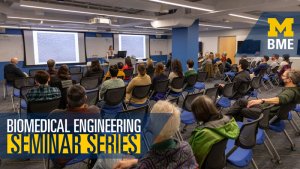Presented By: Biomedical Engineering
Biomedical Engineering Seminar Series
How biophysical cues and hedgehog signaling shape dense connective tissues, with Nathaniel Dyment, PhD

Abstract:
I will tell two stories from my lab. The first story is how biophysical cues dictate the formation and maintenance of dense connective tissues. This work includes how muscle loading during embryogenesis dictates the growth of tissues in the knee joint and how cell contractility regulates cell fate and tissue homeostasis. The second story, which started with a serendipitous discovery during my graduate studies, is focused on how the hedgehog signaling pathway is a master regulator of fibrocartilage formation during enthesis development and tendon-to-bone repair in adults.
Bio:
I obtained my undergraduate degree in Materials Science and Engineering with a specialization in Biomaterials from the University of Illinois at Urbana-Champaign in 2005. I completed my PhD in the Functional Tissue Engineering laboratory under the direction of Dr. David Butler at the University of Cincinnati in 2011. After postdoctoral training in musculoskeletal biology with Dr. David Rowe at UConn Health, I moved to the University of Pennsylvania in 2017, where I developed an independent research program in the McKay Orthopaedic Research Laboratory.
My lab’s primary research goals are directed towards understanding the genetic, cellular, and mechanical mechanisms that regulate normal development, disease, and repair of joint tissues. I am particularly interested in identifying markers that define resident progenitors vs. mature cell types and the environmental cues (molecular and mechanical) that regulate their differentiation. I was awarded a K99/R00 grant in 2015 to define the tendon cell lineage and pathways that regulate tenogenesis, which led to our current work investigating the role of hedgehog signaling in tendon-to-bone repair and developing novel drug delivery systems targeting this pathway to improve repair outcomes. My lab also examines how mechanical forces impact the formation and maintenance of dense connective tissues, which have resulted in a recent publication in PNAS and the formation of the Penn Achilles Tendinopathy Center of Research Translation (PAT-CORT). In 2024, I was awarded the Kappa Delta Young Investigator Award from the AAOS for this work. Ultimately, the long-term goals of my lab are directed towards translating these mechanistic studies to novel therapeutic strategies.
Zoom:
https://umich.zoom.us/j/94801149707
I will tell two stories from my lab. The first story is how biophysical cues dictate the formation and maintenance of dense connective tissues. This work includes how muscle loading during embryogenesis dictates the growth of tissues in the knee joint and how cell contractility regulates cell fate and tissue homeostasis. The second story, which started with a serendipitous discovery during my graduate studies, is focused on how the hedgehog signaling pathway is a master regulator of fibrocartilage formation during enthesis development and tendon-to-bone repair in adults.
Bio:
I obtained my undergraduate degree in Materials Science and Engineering with a specialization in Biomaterials from the University of Illinois at Urbana-Champaign in 2005. I completed my PhD in the Functional Tissue Engineering laboratory under the direction of Dr. David Butler at the University of Cincinnati in 2011. After postdoctoral training in musculoskeletal biology with Dr. David Rowe at UConn Health, I moved to the University of Pennsylvania in 2017, where I developed an independent research program in the McKay Orthopaedic Research Laboratory.
My lab’s primary research goals are directed towards understanding the genetic, cellular, and mechanical mechanisms that regulate normal development, disease, and repair of joint tissues. I am particularly interested in identifying markers that define resident progenitors vs. mature cell types and the environmental cues (molecular and mechanical) that regulate their differentiation. I was awarded a K99/R00 grant in 2015 to define the tendon cell lineage and pathways that regulate tenogenesis, which led to our current work investigating the role of hedgehog signaling in tendon-to-bone repair and developing novel drug delivery systems targeting this pathway to improve repair outcomes. My lab also examines how mechanical forces impact the formation and maintenance of dense connective tissues, which have resulted in a recent publication in PNAS and the formation of the Penn Achilles Tendinopathy Center of Research Translation (PAT-CORT). In 2024, I was awarded the Kappa Delta Young Investigator Award from the AAOS for this work. Ultimately, the long-term goals of my lab are directed towards translating these mechanistic studies to novel therapeutic strategies.
Zoom:
https://umich.zoom.us/j/94801149707